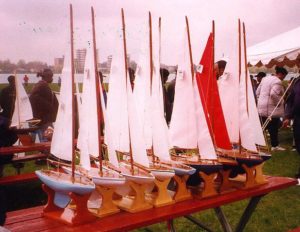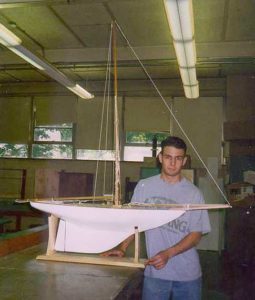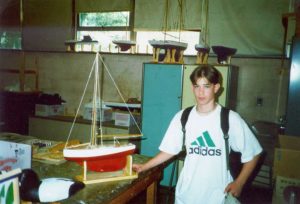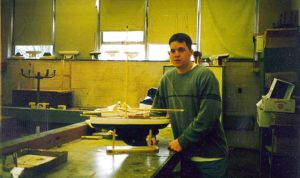Model Yachting and Manual Arts Training in the United States
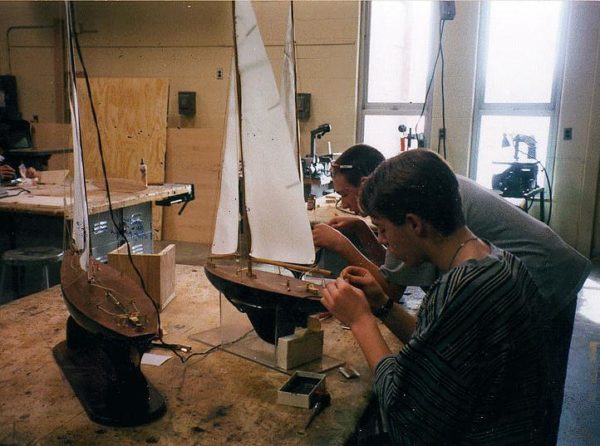
Two 9th Graders (15 years old) rigging their “Detroit 24’s” at Jeannette Jr. High School, Utica, Michigan, 1997.
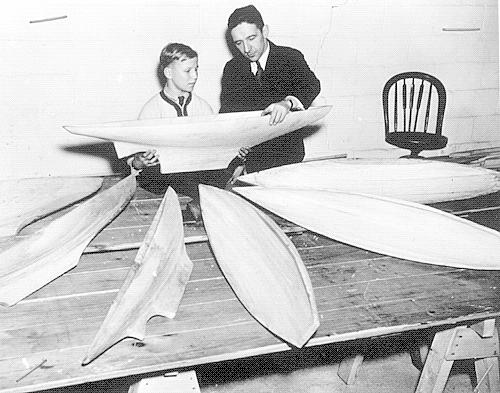
An example of a 1920s school project is documented in Yachting magazine for January 1927. This is an MYRAA Class D boat (52″ LOA, 18 lbs displacement, 1400 in2 of sail), of which 12 were built. This picture, from the 1930s, shows a Works Progress Adminstration class in Salem MA with a similar boat, although this is probably the John Black 6-Meter Kiltie. Photo courtesy of the New Deal Network. Used by permission.
Training in the manual arts has long been emphasized in public education in the United States. It received its greatest emphasis in the years immediately following WWI. The military draft at that period represented the first nationwide survey of the mental and physical status of a large segment of the American population, and what was discovered spurred many reforms and initiatives in areas such as public health, nutrition, and education. A particularly energetic effort was made to replace the old haphazard apprenticeship method with an organized process to produce the skilled artisans whom the war effort had shown to be in short supply. The emphasis on manual arts continued until the education “reforms” of the 1960s.
Manual arts teachers quickly recognized model yachting as providing near-perfect shop projects, especially for introductory courses. Students had to work in wood, metal, and cloth, assemble parts into a working whole, and had the opportunity to see the results of their efforts under sail, with the additional spice of a student regatta. Two notable manual arts teachers in the history of model yachting in the US were Thomas Darling, who designed lovely full-keel boats and wrote the classic Miniature Racing Yachts, and John Black, designer of the Cheerio and Bostonia series of boats, longtime unsuccessful challenger for the Yachting Monthly Cup, and author of Yachting with Models.

In the 1930s the Works Progress Administration under FDR instituted a program to boost employment by constructing parks and other public works. Manual arts teachers lobbied energetically and successfully for the construction of model yacht basins and ponds across the country. It probably didn’t hurt that FDR himself was an avid full-scale and model yachtsman; prior to being stricken with polio he and other Roosevelts skiff-sailed 36″ models across the Hudson River near Hyde Park. Here he is checking with an expert eye the fairness of a model yacht presented to him by a group of schoolchildren. Photo courtesy of the New Deal Network. Used by permission.
The earliest of such authors that we have encountered is John Cavileer, a manual arts teacher whose Model Boat Building for Boys was published in 1923 by Bruce Publishing, a Milwaukee textbook house. Internal evidence indicates that the text was written no earlier than 1920. We have fairly extensive material on American model yachting from the 1890s on, and Cavileer’s book is the first that mentions student boatbuilding and sailing.
This movement also shifted the predominant mode of sailing away from skiff sailing on open water to pond sailing in artificial venues.
One of the most prolific teachers and writers on model boating and model yachts was Claude William Horst of Milwaukee. His books for Bruce Publishing include Model Sail and Power Boats (1933), Model Boats for Juniors (1936), and A Marblehead Model Sailing Yacht (1939). He also published a paperback by the Manual Arts Press, Model Boats for Boys, in 1935.
His “signature” construction method was horizontal lifts, split in half down the centerline and glued to a central keel/backbone, a method that greatly simplified the hollowing of the hull and added strength at the expense of some additional weight.
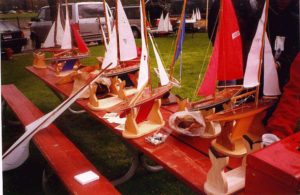
“Detroit Sharpies,” another school class, built by Detroit Public School Students, Belle Isle, 1997.
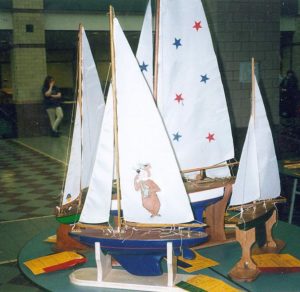
Industrial Arts Contest, Jeannette Junior High, May 1997. Two “Detroit 24s,” one 36″, and one “Sharpie.”
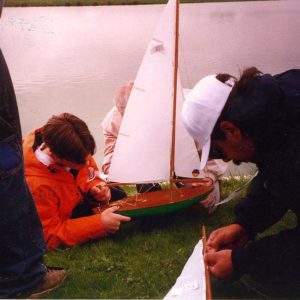
Jeannette Junior High students rig their “24s” before competing against Detroit, Belle Isle, May 1997.
The longest-lived program, and one that continues to this day, operates in the Detroit, MI area. It began in 1927, when a manual arts teacher became interested in the model yacht races sponsored by the city of Detroit and formed a club at his school. Other clubs, and sponsorship by merchants and the Detroit News newspaper followed. The most common design that appears in these events is called a “Detroit 24”, a 24-in LOA boat designed by the teacher Earl Phillips in 1933. Its construction is documented in a 1968 paperback by Phillips and Charles Pozzini called How to Build and Sail a Model Yacht. Full-size plans, and fittings, are still available from the A.J. Fisher Co. of Detroit.
In 1941, the Model Yacht Racing Association of America (MYRAA) attempted to introduce a “Junior” activity by defining what was to all intents and purposes a “36/500″ class of boats. This followed in a long tradition of 36” LOA models as beginner’s boats, starting with the “Alpha” class of New York clubs around 1920 and, interestingly enough, continuing to the CR-914 of today. Almost all of the boats built to this class were “sharpies.” Two notable designs were the MYRAA “S” boat by “Admiral” Walter Maney, who had begun his model yachting activities as a young man in 1880s New York, and John Black’s Starlet, roughly based on the ever-popular Star class of full-sized boats. The “S” boat is the topic of an interesting unpublished work by Ted Houk of Seattle (a pioneer in vane design and designer of the innovated M Class boat Rip Tide) called “Model Yachts by the Fleet,” which describes how a class can be organized first as an assembly line to produce a run of boat kits and then to assemble them individually into finished models.
In the 1940s and 50s the numbers involved in this activity were impressive. In San Diego, CA, in 1948, 700 boats sailed in a “free for all” competition that took 27 heats to resolve. In 1958 between 500 and 600 boats competed at Detroit. Other cities reported similar events with entries in the hundreds; it is not unlikely that the average yearly “production” of school-built boats in the US exceeded a thousand.
The intensity of this activity lies in striking contrast to the decline of “official” model yachting in the U.S. during the same period. The MYRAA recognized three classes: M, X, and International A Class. The M and X classes dominated, and had reached such a high pitch of sophistication, with complex self-tacking vanes and sliding rigs, that the “entry cost” for a beginner was extremely high and the chances of being successful in competition were extremely low. A failed attempt to define a one-design class based on an early M boat, and bitter internal politics didn’t help. As the “old hands” who had sailed against each other for decades died off, so did the sport.
When revitalized under the successor American Model Yacht Association (AMYA), model yachting was quite different: people started with boats from manufacturers, and when enough skippers got interested in racing, classes (typically one-design) were formed. This “bottom up” organization started with the earliest AMYA classes (the Santa Barbara and the East Coast 12 Meter) and continues to this day. The disadvantage is a bewildering array of classes, many moribund; the advantage is that when an interesting boat becomes available, all it takes is 20 owners and the appointment of a class secretary and sanctioned racing can commence. Which, to many, is precisely the point.

